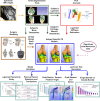Evaluation of anterior cruciate ligament surgical reconstruction through finite element analysis
- PMID: 35577879
- PMCID: PMC9110399
- DOI: 10.1038/s41598-022-11601-1
Evaluation of anterior cruciate ligament surgical reconstruction through finite element analysis
Abstract
Anterior cruciate ligament (ACL) tear is one of the most common knee injuries. The ACL reconstruction surgery aims to restore healthy knee function by replacing the injured ligament with a graft. Proper selection of the optimal surgery parameters is a complex task. To this end, we developed an automated modeling framework that accepts subject-specific geometries and produces finite element knee models incorporating different surgical techniques. Initially, we developed a reference model of the intact knee, validated with data provided by the Open Knee(s) project. This helped us evaluate the effectiveness of estimating ligament stiffness directly from MRI. Next, we performed a plethora of "what-if" simulations, comparing responses with the reference model. We found that (a) increasing graft pretension and radius reduces relative knee displacement, (b) the correlation of graft radius and tension should not be neglected, (c) graft fixation angle of 20[Formula: see text] can reduce knee laxity, and (d) single-versus double-bundle techniques demonstrate comparable performance in restraining knee translation. In most cases, these findings confirm reported values from comparative clinical studies. The numerical models are made publicly available, allowing for experimental reuse and lowering the barriers for meta-studies. The modeling approach proposed here can complement orthopedic surgeons in their decision-making.
© 2022. The Author(s).
Conflict of interest statement
The authors declare no competing interests.
Figures










Similar articles
-
Optimal graft stiffness and pre-strain restore normal joint motion and cartilage responses in ACL reconstructed knee.J Biomech. 2016 Sep 6;49(13):2566-2576. doi: 10.1016/j.jbiomech.2016.05.002. Epub 2016 May 13. J Biomech. 2016. PMID: 27370782
-
[Finite element analysis of the graft stresses after anterior cruciate ligament reconstruction].Beijing Da Xue Xue Bao Yi Xue Ban. 2021 Oct 18;53(5):865-870. doi: 10.19723/j.issn.1671-167X.2021.05.009. Beijing Da Xue Xue Bao Yi Xue Ban. 2021. PMID: 34650286 Free PMC article. Chinese.
-
Sensitivity analysis of the knee ligament forces to the surgical design variation during anterior cruciate ligament reconstruction: a finite element analysis.Comput Methods Biomech Biomed Engin. 2022 Jul;25(9):1063-1071. doi: 10.1080/10255842.2021.2006647. Epub 2021 Nov 25. Comput Methods Biomech Biomed Engin. 2022. PMID: 34821520
-
A Biomechanical Comparison of Single-, Double-, and Triple-Bundle Anterior Cruciate Ligament Reconstructions Using a Hamstring Tendon Graft.Arthroscopy. 2019 Mar;35(3):896-905. doi: 10.1016/j.arthro.2018.10.124. Epub 2019 Feb 4. Arthroscopy. 2019. PMID: 30733036
-
Current concepts in anatomic single- and double-bundle anterior cruciate ligament reconstruction.Phys Sportsmed. 2011 May;39(2):140-8. doi: 10.3810/psm.2011.05.1905. Phys Sportsmed. 2011. PMID: 21673495 Review.
Cited by
-
Biomechanics of horizontal meniscus tear and healing during knee flexion: Finite element analysis.Mechanobiol Med. 2025 Mar 13;3(2):100128. doi: 10.1016/j.mbm.2025.100128. eCollection 2025 Jun. Mechanobiol Med. 2025. PMID: 40395773 Free PMC article.
-
Model Properties and Clinical Application in the Finite Element Analysis of Knee Joint: A Review.Orthop Surg. 2024 Feb;16(2):289-302. doi: 10.1111/os.13980. Epub 2024 Jan 4. Orthop Surg. 2024. PMID: 38174410 Free PMC article. Review.
-
Knee Arthroscopy in the Era of Precision Medicine: A Comprehensive Review of Tailored Approaches and Emerging Technologies.Cureus. 2024 Oct 6;16(10):e70932. doi: 10.7759/cureus.70932. eCollection 2024 Oct. Cureus. 2024. PMID: 39502973 Free PMC article. Review.
-
Can MRI predict return to sport after anterior cruciate ligament reconstruction? A systematic review of the literature.Radiol Med. 2025 May;130(5):638-649. doi: 10.1007/s11547-025-01973-5. Epub 2025 Mar 10. Radiol Med. 2025. PMID: 40063165 Free PMC article.
-
Knee instability caused by altered graft mechanical properties after anterior cruciate ligament reconstruction: the early onset of osteoarthritis?Front Bioeng Biotechnol. 2023 Aug 24;11:1244954. doi: 10.3389/fbioe.2023.1244954. eCollection 2023. Front Bioeng Biotechnol. 2023. PMID: 37691908 Free PMC article.
References
-
- Laskowski, E. Acl injury and rehabilitation. Curr. Phys. Med. Rehabil. Rep.2. 10.1007/s40141-013-0036-8 (2014).
-
- Wetters, N., Weber, A., Wuerz, T., Schub, D. & Mandelbaum, B. Mechanism of injury and risk factors for anterior cruciate ligament injury. Oper. Tech. Sp. Med.24. 10.1053/j.otsm.2015.09.001 (2015).
Publication types
MeSH terms
LinkOut - more resources
Full Text Sources
Medical

